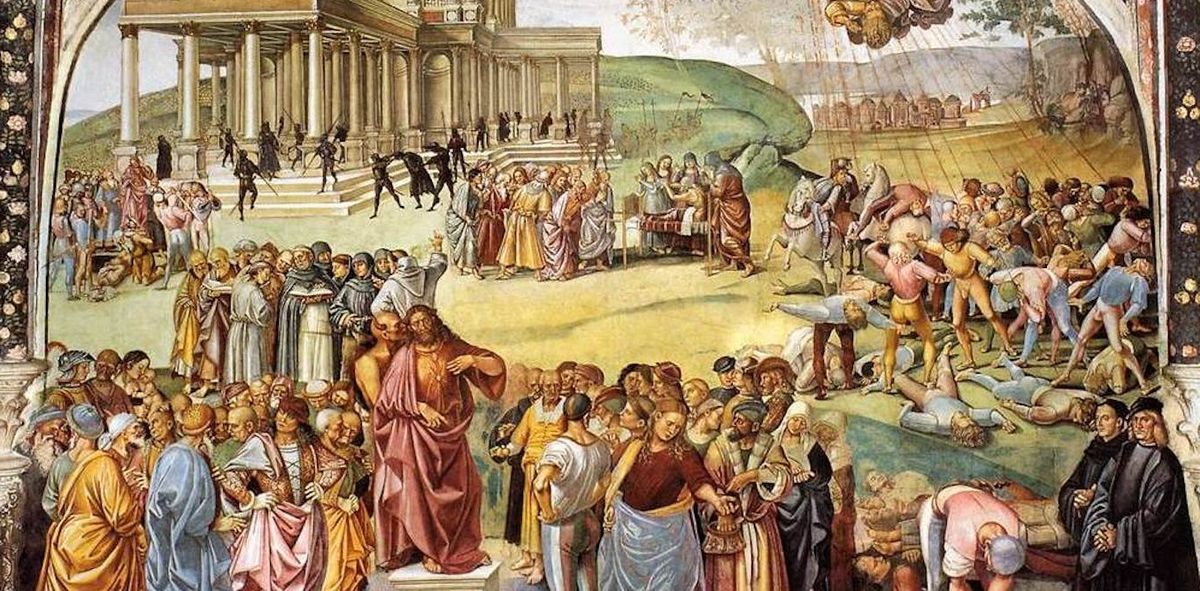
The concept of the Antichrist has fascinated and terrified people for centuries. Rooted in Christian eschatology, this figure represents the ultimate adversary of Christ and the embodiment of evil. The term "Antichrist" comes from the Greek words "anti" (against) and "Christos" (Christ), signifying someone who opposes Christ. Mentioned in the New Testament, particularly in the Book of Revelation and the Epistles of John, the Antichrist is often depicted as a charismatic leader who deceives many with false promises of peace and unity. Throughout history, various individuals, from Roman emperors to modern political figures, have been speculated to be the Antichrist. This enduring symbol of rebellion against God continues to captivate imaginations and fuel countless theories.
Understanding the Antichrist
The Antichrist is a figure deeply rooted in Christian eschatology, representing the ultimate adversary of Christ and the embodiment of evil. This concept has evolved over centuries, with various interpretations and speculations. Here are 45 key facts about the Antichrist to help you understand this enigmatic figure.
-
Definition: The term "Antichrist" comes from the Greek words "anti" (against) and "Christos" (Christ). It refers to a figure who opposes Christ and the Christian faith.
-
New Testament Usage: The term "Antichrist" appears five times in the New Testament: in 1 John 2:18, 2:22, 4:3, 2 John 1:7, and 1 John 4:3.
-
Early Church: The concept of the Antichrist was first mentioned in the Odes of Solomon, a second- or first-century book written by an Essene convert to Christianity. The Odes describe the Antichrist as a monstrous dragon that the redeemer overcomes.
-
Polycarp: Polycarp (c. 69 – c. 155 AD) was one of the late 1st-/early 2nd-century Apostolic Fathers to use the term "Antichrist." He warned the Philippians that everyone who preached false doctrine was an antichrist.
-
Irenaeus: Irenaeus (2nd century AD – c. 202 AD) wrote Against Heresies to refute the teachings of the Gnostics. He referred to the Antichrist as the "recapitulation of apostasy and rebellion" and numerologically decoded several possible names, including "Evanthos" and "Lateinos" (pertaining to the Roman Empire).
Historical and Biblical Context
The Antichrist has been a subject of speculation and interpretation throughout history. Various figures have been identified as potential Antichrists, and biblical texts provide vivid descriptions of this adversary.
-
Historical Antichrists: Throughout history, various individuals have been identified as potential Antichrists. These include Roman emperors like Nero, who persecuted Christians, and Antiochus IV Epiphanes, who attempted to extirpate Judaism.
-
Book of Revelation: The Book of Revelation refers to the Antichrist as "the Beast from the Abyss" (11:7) and "the Beast from the Sea" (13:1). This figure is described as having seven heads and ten horns, symbolizing its power and influence.
-
Characteristics: According to Christian tradition, the Antichrist will promise peace and unity to the world but will ultimately bring destruction and chaos. He will be charismatic and persuasive, deceiving many people with his false promises.
-
Mark of the Beast: The Antichrist will force people to receive a mark on their right hand or forehead, which is the number 666 (Revelation 13:18). This mark will be necessary for buying and selling, symbolizing total control over the economy.
-
False Prophet: The Antichrist will have a false prophet who helps him gain control over the world economy and deceive people into receiving the mark.
Prophecies and Symbolism
Prophecies about the Antichrist are filled with symbolism and vivid imagery. These prophecies have been interpreted in various ways, leading to different understandings of the Antichrist's role and characteristics.
-
Mortal Wound: One of the heads of the Beast will seem to have a mortal wound but will be healed, and the whole earth will follow the Beast with wonder (Revelation 13:3).
-
Global Domination: The Antichrist will rise to a position of great power and control over the world, forging a one-world government through his promises of peace.
-
Battle of Armageddon: According to Christian prophecy, Jesus will return and defeat the Antichrist in the Battle of Armageddon, exposing him as an impostor and reigning with the Christian martyrs for a thousand years on earth.
-
Historical Speculation: Throughout history, various individuals have been speculated to be the Antichrist. For example, during the Middle Ages, the Pope was often seen as the Antichrist by Protestant reformers like Martin Luther.
-
Modern Interpretations: In modern times, some Evangelical and fundamentalist Christians have identified specific individuals as the Antichrist, such as Barack Obama, who was the subject of conspiracy theories claiming he met 14 out of 16 characteristics required for being Antichrist.
Modern Speculations and Cultural Impact
The concept of the Antichrist continues to captivate modern minds, leading to various speculations and cultural representations. From political figures to popular culture, the Antichrist remains a topic of intrigue.
-
Barack Obama as Antichrist: The association of Barack Obama with the Antichrist was fueled by conspiracy theories that linked him to biblical prophecies. These claims were largely discredited by fact-checking organizations like Politifact.
-
Scientology and L. Ron Hubbard: In Scientology, founder L. Ron Hubbard referred to himself as the Antichrist in a document, defending humanity against an alien invasion. This reference was later removed from the document after Hubbard's death.
-
Baha'i Faith: In the Baha'i faith, the Antichrist is seen as a force that subverts the inner reality of man, leading to discord and hatred instead of unity and love.
-
Popular Culture: The concept of the Antichrist has been explored in popular culture, including films like Rosemary’s Baby and The Omen, as well as literature and music.
-
Vladimir Solovyov: In 1900, Russian philosopher Vladimir Solovyov published A Short Tale of the Antichrist, which prophesied that the Antichrist would present himself as a pacifist, animalist, ecologist, and philanthropist.
Conspiracy Theories and Symbolism
The Antichrist is often associated with conspiracy theories and symbolic representations. These theories and symbols reflect the enduring fascination with this figure.
-
Conspiracy Theories: The enthronement of the Antichrist is often associated with conspiracy theories, particularly a Satanic plot to destroy the Christian faith in St. Nicholas.
-
The 1975 and Eminem: The term "Antichrist" has been used in music by bands like The 1975 and Eminem, often symbolizing rebellion and opposition to societal norms.
-
American Horror Story: Apocalypse: In the FX series American Horror Story: Apocalypse, the character Michael Langdon is labeled as the Antichrist and brings upon the end times.
-
Medieval Antichrist Tradition: The medieval tradition of identifying the Antichrist as a specific coming individual has given way to the view of Antichrist as a collective body of evil. This shift was influenced by Martin Luther's insistence that the institution of the papacy was Antichrist.
-
Roman Catholic View: Roman Catholics have become less inclined to identify Antichrist as a specific coming individual, instead viewing it as a collective body of evil.
Religious Perspectives and Interpretations
Different religious traditions have their own interpretations of the Antichrist. These perspectives provide a broader understanding of this complex figure.
-
Jewish Traditions: The Christian conception of Antichrist was derived from Jewish traditions, particularly The Book of Daniel in the Hebrew Bible. Daniel foretold the coming of a final persecutor who would “speak great words against the most High and wear out the saints of the most High” (7:25).
-
Hellenistic Ruler: The author of Daniel was alluding to the contemporary Hellenistic ruler Antiochus IV Epiphanes, who attempted to extirpate Judaism. Later readers applied this prediction to any persecutor, including Roman emperors like Nero.
-
New Testament Books: The four books of the New Testament that fueled Christian belief in Antichrist were the first two epistles of John, the Revelation to John, and the Second Letter of Paul to the Thessalonians. These books refer to a coming persecutor who is evidently the same person as the Antichrist.
-
Distinction Between Antichrists: The first epistle of John introduces an important distinction between “the” Antichrist who will come and the many antichrists who are already active in the world. This distinction allowed believers to denigrate contemporaries as “antichrists” without having to label a single individual as “the” Antichrist.
-
Collectivity of Antichrist: The view of Antichrist as a collective body of evil was made concrete and popular by Martin Luther. He insisted that the institution of the papacy, rather than any given pope, was Antichrist.
Modern Religious Views
Modern religious views on the Antichrist vary, reflecting different theological perspectives and interpretations of biblical prophecy.
-
Protestant View: Modern Protestants have characteristically preferred to conceive of Antichrist as whatever resists or denies the lordship of Christ. However, the idea of an individual as the Antichrist gained popularity among some Evangelical and fundamentalist Christians in the 20th century.
-
Roman Catholic View: Roman Catholics have become less inclined to identify Antichrist as a specific coming individual. Instead, they view Antichrist as a collective body of evil that resists or denies the lordship of Christ.
-
Medieval Antichrist Tradition: Vestiges of the medieval Antichrist tradition can be found in contemporary popular culture, such as Hollywood films like Rosemary’s Baby and The Omen and its sequels. The view of Antichrist as a diabolical institution is also reflected in the superstition that credit cards and electronic bar codes mysteriously mark innocent people with Antichrist’s sign, the number 666 (Revelation 13:18).
-
Conspiracy Theories: The Antichrist is often associated with conspiracy theories, particularly a Satanic plot to destroy the Christian faith in St. Nicholas. These theories have been perpetuated through various media and cultural expressions.
-
Symbolism of 666: The number 666 is a symbol of the Antichrist and is often associated with the mark of the Beast. This number is derived from Revelation 13:18, where it is stated that the number of the Beast is 666.
Characteristics and Actions
The Antichrist's characteristics and actions are vividly described in biblical prophecy. These descriptions have led to various interpretations and speculations.
-
False Prophet: The Antichrist will have a false prophet who helps him gain control over the world economy and deceive people into receiving the mark. This false prophet will be instrumental in spreading false doctrine and leading people astray.
-
Global Economic Control: The Antichrist will gain control over the world economy by forcing each person to receive the mark. This control will be total, with no one able to buy or sell without the mark.
-
Charismatic Leadership: The Antichrist will be charismatic and persuasive, deceiving many people with his false promises of peace and unity. He will have a massive Christ-like appeal, drawing people to him with his words and actions.
-
End Times Prophecy: The Antichrist is part of end times prophecy, which foretells the final days of humanity before the return of Christ. The Antichrist will play a central role in these events, leading to the Battle of Armageddon and the ultimate defeat of evil.
Historical and Modern Speculations
Speculations about the Antichrist have persisted throughout history and continue in modern times. These speculations often arise from interpretations of biblical prophecies and the characteristics attributed to the Antichrist.
-
Historical Speculation: Throughout history, various individuals have been speculated to be the Antichrist. These speculations often arise from interpretations of biblical prophecies and the characteristics attributed to the Antichrist.
-
Modern Interpretations: In modern times, some Evangelical and fundamentalist Christians have identified specific individuals as the Antichrist. These claims are often based on interpretations of biblical prophecies and the characteristics attributed to the Antichrist.
-
Scientology and L. Ron Hubbard: In Scientology, founder L. Ron Hubbard referred to himself as the Antichrist in a document, defending humanity against an alien invasion. This reference was later removed from the document after Hubbard's death.
-
Baha'i Faith: In the Baha'i faith, the Antichrist is seen as a force that subverts the inner reality of man, leading to discord and hatred instead of unity and love. This view emphasizes the spiritual nature of the conflict between good and evil.
-
Popular Culture: The concept of the Antichrist has been explored in popular culture, including films like Rosemary’s Baby and The Omen, as well as literature and music. These works often symbolize rebellion and opposition to societal norms.
-
Enduring Symbolism: The Antichrist remains an enduring symbol of evil and opposition to God in Christian eschatology. His characteristics and actions are deeply rooted in biblical prophecy and continue to be interpreted and speculated upon by believers and scholars alike, making him an enduring figure in human imagination.
The Enduring Symbol of Evil
The Antichrist has fascinated and terrified people for centuries. Rooted in biblical prophecy, this figure represents ultimate evil and opposition to Christ. From early mentions in the New Testament to modern interpretations, the Antichrist has evolved but remains a powerful symbol. Historical figures like Nero and Antiochus IV Epiphanes have been labeled as such, while modern conspiracy theories have pointed to individuals like Barack Obama. The Antichrist is often depicted as charismatic, deceptive, and controlling, promising peace but bringing chaos. Popular culture, including films like The Omen and Rosemary’s Baby, keeps this figure in the public eye. Whether seen as a single entity or a collective force of evil, the Antichrist continues to captivate and intrigue, embodying humanity's deepest fears and moral struggles.
Was this page helpful?
Our commitment to delivering trustworthy and engaging content is at the heart of what we do. Each fact on our site is contributed by real users like you, bringing a wealth of diverse insights and information. To ensure the highest standards of accuracy and reliability, our dedicated editors meticulously review each submission. This process guarantees that the facts we share are not only fascinating but also credible. Trust in our commitment to quality and authenticity as you explore and learn with us.


